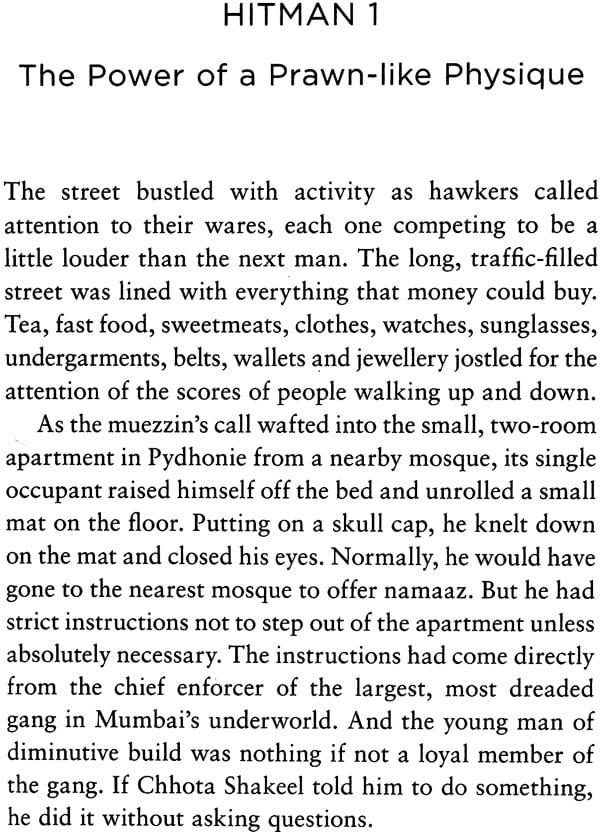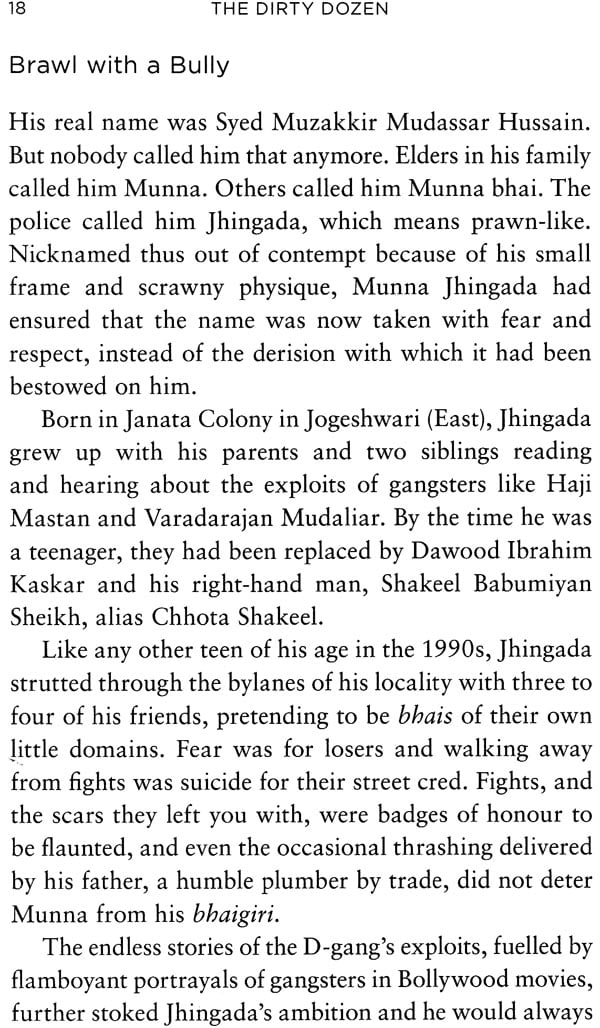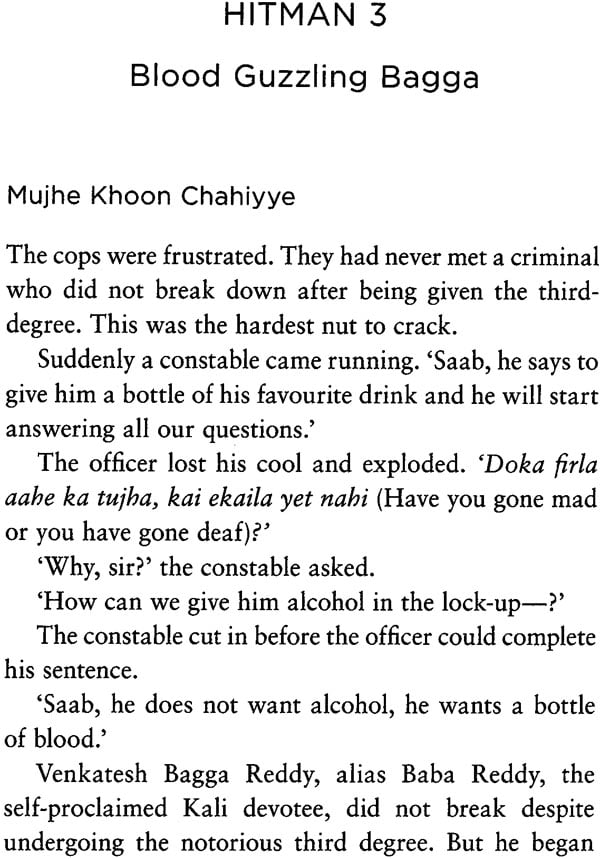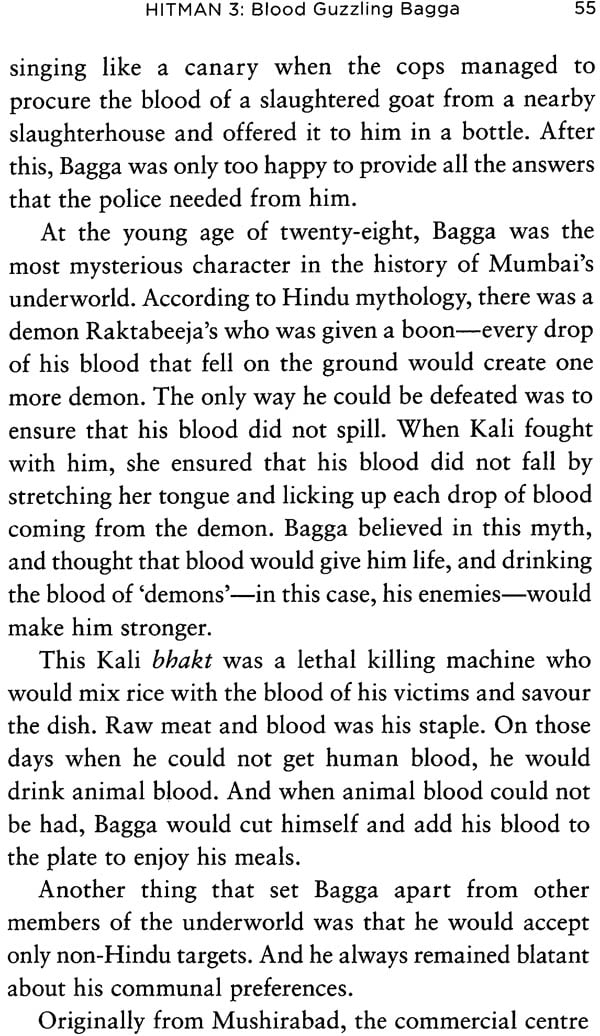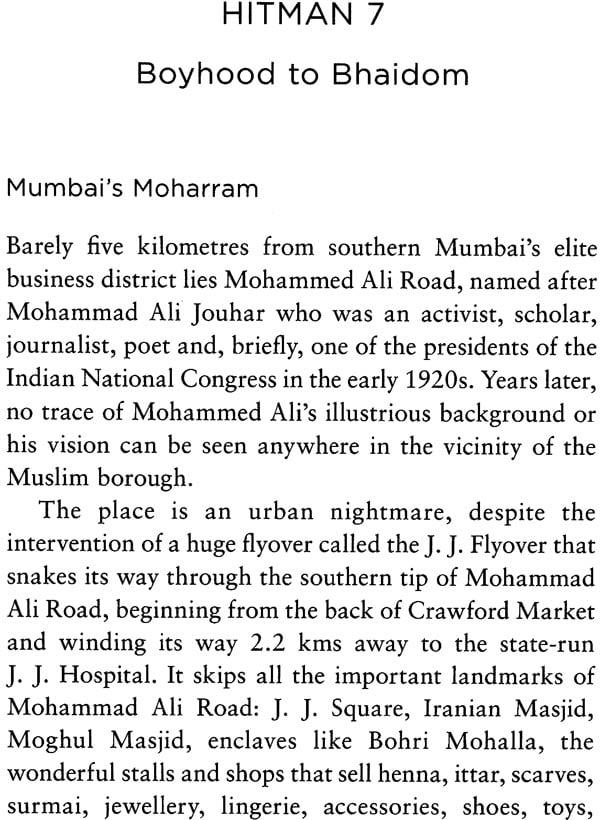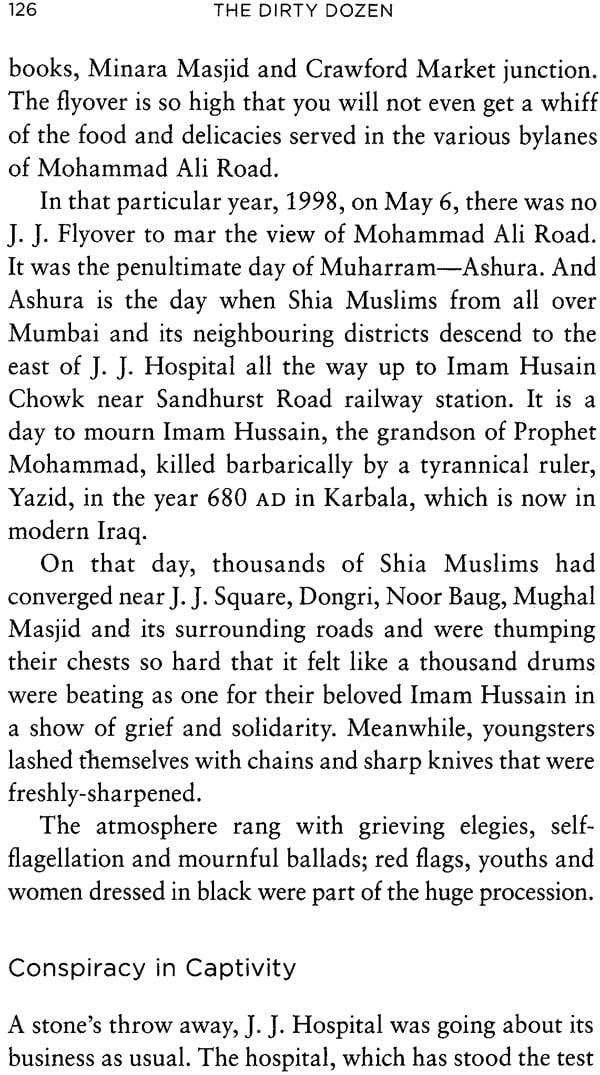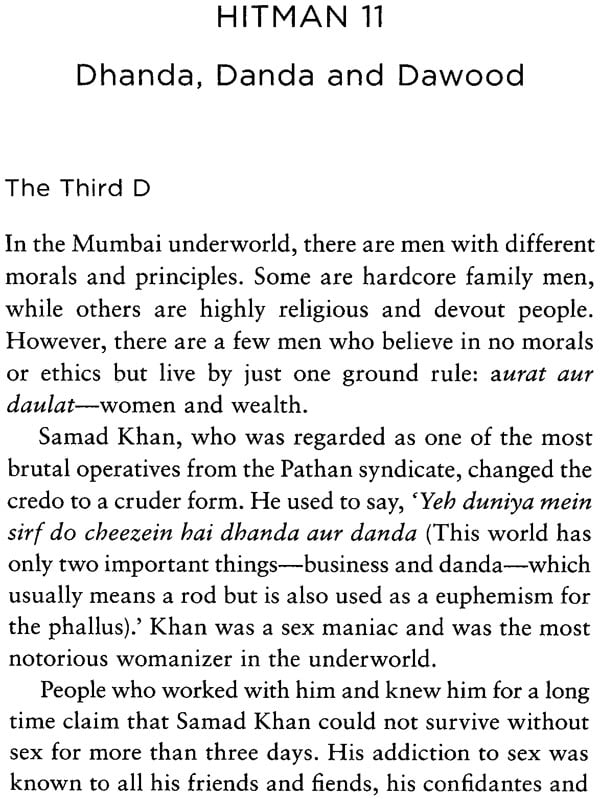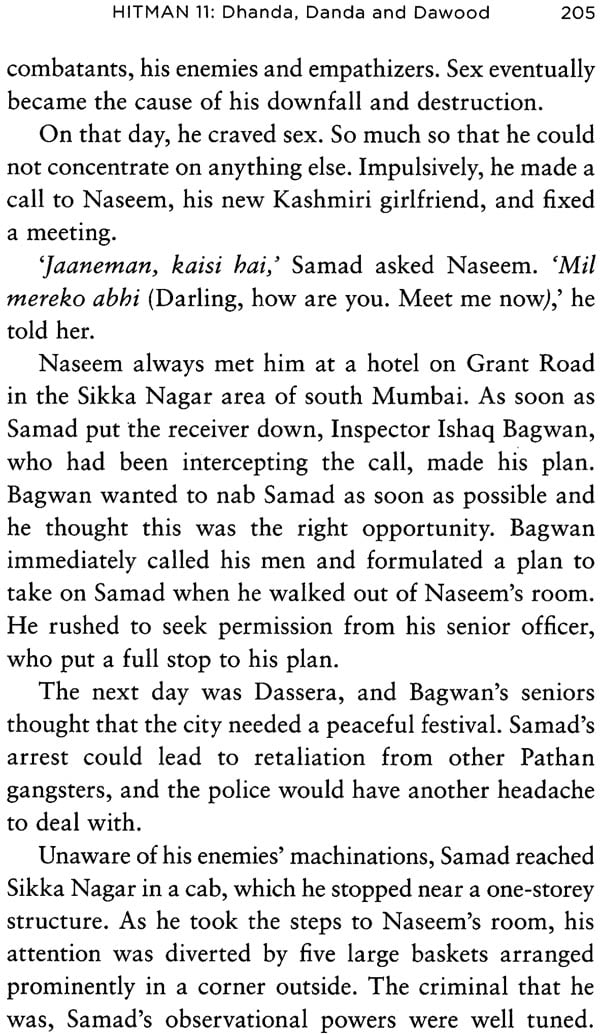
The Dirty Dozen: Hitmen of Mumbai Underworld
Book Specification
| Item Code: | NAO688 |
| Author: | S. Hussain Zaidi |
| Publisher: | Westland Ltd. |
| Language: | English |
| Edition: | 2017 |
| ISBN: | 9789386850133 |
| Pages: | 240 |
| Cover: | Paperback |
| Other Details | 8.0 inch X 5.5 inch |
| Weight | 180 gm |
Book Description
Gabriel Khan is the pseudonym for a veteran crime reporter from Mumbai. With experience of over twenty-five years in journalism—mainly print and stints with television and dotcoms—Gabriel is a reservoir of information on the city's underbelly. Gabriel has also done a lot of handholding for several budding journalists, many of whom have now established their bylines.
Gabriel Khan also co-authored with S. Hussain Zaidi on his debut fiction, Mumbai Avengers, which was subsequently made into a blockbuster movie titled Phantom, directed by Kabir Khan.
Gabriel Khan has also converted the movie Special 26 into a novella.
I started my career in journalism at a time when typewriters were treasured and when newsrooms were not cold, clinical, impersonal cabins with corporate trappings. The newsrooms of my time were huge, with an open plan area. There were tennis table-size wooden desks, one for the reporting team and another for the editing team. A long row of benches was where the reporters sat and typed away their copies on Godrej typewriters. There was a place for the teleprinter, from where we got the wires—PTI, UNI, Reuters. And yes, we also had a tribe called proof-readers, who were the last in the news food chain. No gaffe escaped their sharp eyes. The features desk was lucky fellas who generally got cabins and lived life kingsize, with only weekly Sunday pages to fill. They didn't have to produce two stories a day, or so we thought.
The newsrooms were always messy, with lots of papers, notebooks, and printouts. The journalists hung their jhola bags from their plastic woven wooden chairs or metal chairs woven with plastic. Typewriters were at a premium and there was a mad scramble for non-defective ones with all their keys intact. If you were lucky to start your career at the training ground, The Free Press Journal or Indian Express, the sea view was a bonus. When the muse didn't work, one could always find inspiration in the angry turbid Arabian Sea that was pushed into a corner at the end of Free Press Journal Marg in Nariman Point.
There were a couple of black rotary dial phones in the room, but you could make a call only if the telephone operator—seated in her lofty cabin near the entrance—deigned to connect your number. You had to keep the telephone operator very happy. Direct phone lines were only for the editor and, sometimes, the chief reporter. You could chain-smoke in the newsroom and both male and female journalists puffed away to glory. The chaiwallah was always being summoned for endless cups of tea punctuated with bhajjis and sandwiches. And the chaiwallah was always asking for money and the journalists were always broke.
Some journalists wore long kurtas and jeans, while others wore shirts that were never tucked into their pants. Most male journalists had a moustache and a beard or stubble. You would find only a handful of clean-shaven ones. They looked like poets and spoke with the air of one having to carry the burden of mankind on their shoulders. The female journalists cut their hair into a very short crop and were strong-willed. They, too, loved khadi and were always informally dressed. And yes, they wore sarees too.
Newsrooms transitioned to computers within two years of my new career in journalism, and the now defunct Indian Post was the first paper to get Atex computers which, in the late '80s, had military applications. Reporters could send messages to each other on their computers, the first version of Gmail chats. And yes, it was the era of newspaper clippings and libraries for background research. Sans Google, journalism was none the poorer.
It was an era when journalists were not discriminatory in what they read. It was an eclectic choice of reading material: Aleksandr Solzhenitsyn, Graham Greene, Jane Austen, Roald Dahl, Agatha Christie and Jeffrey Archer. I loved the feel and pulse of journalism and I never thought beyond it. There was something magical about it. The feeling that we were instruments of social change and that we had a responsibility to society and mankind. That we were not mere chroniclers of our times, but shaped opinions and changed perceptions and that our pen was actually mightier than the sword. (The disillusionment came much later, with age and wisdom.)
In the late '80s, when I started my career in journalism, journalists were an intrepid lot. They wrote stories that could bring down governments. Arun Shourie had ripped apart A. R. Antulay in the cement scam, and Maneck Davar exposed the link between Dhirubhai Ambani's Reliance Industries and the Central Bureau of Investigation director Mohan Katre. (Davar posed as a small scale detergent manufacturer and entrapped Katre's son Umesh into revealing his business dealings with Reliance.) It was an era when journalists wrote in shorthand but were not stenographers. It was when movies reflected the times we lived in, like Saaransh and Ardh Satya. There was no political censure and no censor.
It was a time when journalists were skeptical about politicians and their intent. For journalists, the establishment was always to be questioned. The politicians were always the snake in the grass. Pakistan was a country that got separated at birth. We watched Tames with pain in our hearts. We were not at war with Pakistan every day, as television channels now are. And that was because we focused on the here and now. We had local issues and starvation, poverty, bad infrastructure, poor governance, corruption, tribal issues, zilla parishad scams, farmers' problems, communal riots, the Bhopal gas tragedy, a burning Punjab, Kalahandi and Bhagalpur. It was a time when the Page 3 social scene idea was just incubating in some party-hopper's mind.
It was a time when the great Vinod Mehta turned the definition of investigative and interesting journalism on its head. The Sunday Observer was a trail-blazing newspaper. It shook the behemoth, especially the Old Lady of Boribunder.
I started writing on crime occasionally, while covering other beats. Crime reporting was challenging because getting contacts was not easy unless one wanted to report only the police version. When I met S. Hussain Zaidi, he was a promising young man, all of twenty-seven, shy and reserved. He was heavily into reading paperbacks and was very promising. His narrative skills were in place even at that formative stage in his life. I thought he should be taken under my wing. Over several bun maskas at Yazdani Bakery in Fort, and gallons of carrot juice, Hussain's destiny and future was shaped as the top crime journalist of Mumbai.
When I moved to television for a year, Hussain established himself as a crime reporter of much merit at the Indian Express, which had just launched its city supplement under Sai Suresh Sivaswamy. It was called the Express Newsline. Hussain's stories were creating waves and the Rotary Club had already invited him as a guest. He spoke on 'How not to fear the dreaded extortion call'. Since we were never in competition we became buddies and in him I discovered a hungry protégé. With experience and subsequent success, he built better contacts and collected more scoops. In the early days, he was very humble and did not think it beneath him to touch my feet even in public on Guru Purnima. He once bent and touched my feet in a public square at Matunga Circle.
My crime contacts were virtual encyclopedias and had more archived facts in the recesses of their brains than the Mumbai police had in their dog-eared dossiers. Sadly, most of them have been felled by death. A few I can name. The late chief of the Anti Terror Squad (ATS) Hemant Karkare, Customs Inspector Farooq Batatawala, Deputy Commissioner of Police Deepak Jog, ganglord Hussain Shaikh alias Ustara, Dilawar Khan, killed at twenty-eight, and Badshah, who I think is still alive. I introduced Hussain to my sources back then, and he was an instant hit with them.
Though Hussain and I held divergent points of view on most topics, we were bound together by our shared common destiny—crime reporting. In his journalistic career, Hussain unravelled the Mumbai mafia like no other journalist has ever done.
| Introduction | vii | |
| Prologue: A Gangstar's Lair | 1 | |
| HITMAN 1: | The Power of a Prawn-like Physique | 17 |
| HITMAN 2: | The Jettisoned Official Killer | 35 |
| HITMAN 3: | Blood Guzzling Bagga | 54 |
| HITMAN 4: | The Maya of Mobstres | 67 |
| HITMAN 5: | The Mama of Maharashtrian Mafia | 88 |
| HITMAN 6: | The Ghost Who Killed | 106 |
| HITMAN 7: | Boyhood to Bhaidom | 125 |
| HITMAN 8: | From Political Assassin to Padre | 147 |
| HITMAN 9: | Bulletproof Bora Becomes Baba | 163 |
| HITMAN 10: | The Saga of Sunil and Sulaiman | 185 |
| HITMAN 11: | Dhanda, Danda and Dawood | 204 |
| Epilogue: | Gunmen's Gaffes | 220 |
